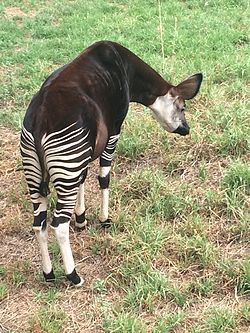Pretoria Zoo
| Pretoria Zoo | |
|---|---|
 | |
 Okapi at Pretoria Zoo | |
 | |
| 25°44′18″S 28°11′21″E / 25.73833°S 28.18917°E | |
| Date opened | 21 October 1899 |
| Location | 232 Boom Street, Pretoria, South Africa |
| Land area | 85 hectares (210 acres)[1] |
| No. of animals | About 9,000[1] |
| No. of species | About 700[1] |
| Annual visitors | More than 600,000[1] |
| Memberships | WAZA, PAAZA, AKAA |
| Major exhibits | Aquarium, Aviary, Mammals, Reptiles |
| Management | South African National Biodiversity Institute |
| Website | https://www.pretoriazoo.org/ |

The National Zoological Garden of South Africa (Afrikaans: Nasionale Dieretuin van Suid-Afrika; also informally known as The Pretoria Zoo) is an 80-hectare (200-acre)[2] zoo located in Pretoria, South Africa. It is the national zoo of South Africa, and was founded by J. W. B. Gunning in 1899. Pretoria Zoo is one of the eight largest zoos in the world.[3]
History
[edit]The farm Klein Schoemansdal, the property of Z.A.R. president Stephanus Schoeman, was sold to Johannes Francois Celliers who renamed it Rus in Urbe. It was acquired by the state in 1895,[4] and the zoological garden was established at the outbreak of the Second Boer War in 1899.[5] It became the official National Zoological Gardens in 1916. After a period of management under the auspices of the South African National Research Foundation, the Pretoria Zoo today is management under the umbrella of the South African National Biodiversity Institute (SANBI).[6]
In 2024, the zoo transferred its last elephant, Charley, to a wildlife reserve following negotiations between the South African government and animal rights groups protesting against his confinement.[7]
Landscape
[edit]Half of the zoo is situated on relatively flat ground, while the other half is located on the slopes of a hill. The two areas are separated by the Apies River flowing through the zoo. Two bridges provide access over the river.
Infrastructure
[edit]Around 6 kilometres (3.7 mi) of pathways are laid out in the zoo. Golf carts are available for rent for those that prefer not to walk; most, but not all of the exhibits are accessible by golf cart. A cable car links the top of the hill with a point close to the entrance at the bottom. Two restaurants are located within the zoo, besides a picnic area on the banks of the Apies River. A crafts market is located outside the zoo entrance.
Exhibits
[edit]| Group | Species[1] | Animals[1] |
|---|---|---|
| Mammals | 209 | 3117 |
| Birds | 202 | 1358 |
| Fish | 190 | 3871 |
| Invertebrates | 4 | 388 |
| Reptiles | 93 | 309 |
| Amphibians | 7 | 44 |
| Total | 705 | 9087 |
Proceeding from the entrance a visitor encounters a walk-through aviary, enclosures for African penguins, Cape fur seals, leopards, flamingoes, and lemurs, further bird aviaries and the hamadryas baboon and monkey enclosures along the western boundary.
At the centre of the zoo large sections are set aside for the African savannah waterhole and a set of large enclosures for smaller carnivores, cheetahs, black and white rhinos, giraffes, African bush elephants, hippos, plains zebras, African buffaloes and okapis respectively. Amongst these are smaller enclosures for primates, African wild dogs, red kangaroos and breeding units for birds.
Against the northern hillside are large enclosures for lions, tigers, brown bears, Nubian ibexes, western lowland gorillas and other animals. In the western section the zoo includes two aquariums, and a reptile park, accessed via a separate entrance.
Gallery
[edit]-
Cableway over the zoo
-
Inside the aviary
-
Pretoria skyline seen from within the aviary
-
Apies River flowing through the zoo
-
African savannah exhibit
-
Lions in the hill enclosure
-
A shady walkway
-
Upper story of the Aviary
-
From inside the ramparts at the top of the hill
-
Pretoria skyline from the zoo
-
Pretoria from the zoo
References
[edit]- ^ a b c d e f "About Us". nzg.ac.za. The National Zoological Gardens of South Africa. Archived from the original on 13 April 2013. Retrieved 5 June 2012.
- ^ "NZG | e-News: Which zoo would you regard as the best in the world? Well, according to a travel blogs there are several zoos that fit this bill. Here they are". Archived from the original on 2019-09-05.
- ^ "8 Largest Zoos in the World".
- ^ Versluis, Jeanne-Marié (4 January 2012). "Reuse-vyeboom op kampioen-lys". Beeld. Archived from the original on 9 April 2015. Retrieved 9 January 2013.
- ^ H. T. Montague Bell, C. Arthur Lane, British Association for the Advancement of Science, Meeting, South African Association for the Advancement of Science (1905). A Guide to the Transvaal. Bartholomew & Lawlor. p. 21. Retrieved 2010-01-05.
{{cite book}}: CS1 maint: multiple names: authors list (link) - ^ "Our history – National Zoological Garden, Pretoria".
- ^ "South Africa's national zoo frees its last elephant". GMA News. 22 August 2024.











